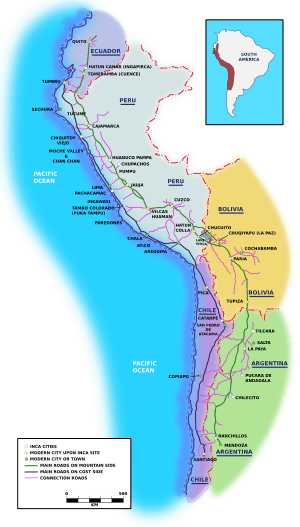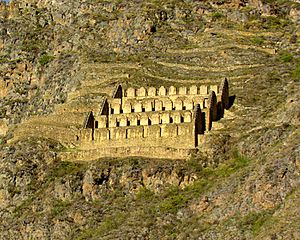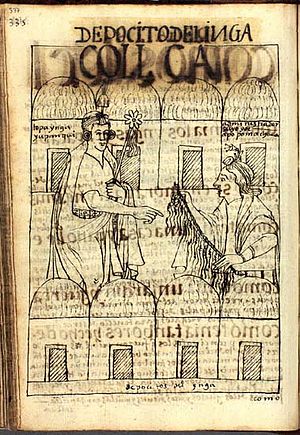Qullqa facts for kids
A qullqa (pronounced "kool-ka") was a special storage building used by the Inca Empire. These buildings were found along Inca roads and near important cities. The Incas stored huge amounts of food and other goods in qullqas. They could then give these supplies to their armies, officials, and workers. When people needed help, especially during bad harvests, the stored food was given to them. Building many qullqas was important because farming was difficult in the high mountains where most of the Inca Empire was located.
Contents
Why the Incas Needed Qullqas
The ancient civilizations in the Andes mountains, like the Incas, had to find ways to feed millions of people. Much of the Inca Empire was in high places, from about 3,000 to over 4,000 meters (9,800 to 13,000 feet) high. In these areas, crops could be damaged by frost, hail, and dry weather.
Tropical plants could not grow well there. A main crop, maize (corn), usually could not grow above 3,200 meters (10,500 feet). People in higher areas grew potatoes, quinoa, and other root crops. Raising llamas and alpacas was also important for meat, wool, and carrying goods.
The Incas did not have big rivers for boats, wheeled carts, or large animals like horses to carry goods. Llamas could carry some items, but not huge amounts quickly. Also, the Incas did not use money or a big trading system. So, food and other items were stored close to where they were made. The government then gave them out when needed.
The Incas built a very large and organized system of qullqas. This helped them collect and store food during good harvest years. Then, they could give it out when there were shortages. Many qullqas were built near important government centers, state farms, temples, and royal homes. Qullqas were also built at every "tambo". These were inns about 22 kilometers (14 miles) apart along the 40,000 kilometers (25,000 miles) of royal roads.
Qullqas mainly supplied Inca officials and armies. Soldiers used the stored food instead of taking food from local farmers. This was different from how most armies got food back then. Stored items, especially food, were also used for big parties and ceremonies. These events helped connect the rulers with their people. Food was also given to everyone if crops failed or there wasn't enough to eat.
What the Incas Stored
The items stored in qullqas changed depending on what was grown in each area. At Wanuku Pampa in central Peru, a major Inca center, most qullqas stored dried potatoes and other root crops. Only a small part stored maize. This was because maize did not grow well in the high, cool climate there. Root crops were stored in layers with straw. Maize was removed from the cob and kept in large jars.
Other farm products stored in qullqas included quinoa, beans, other vegetables, and dried meat (jerky). Seeds were also kept for planting. Non-farm goods stored included:
- Textiles and clothing
- Wool, cotton, and feathers (used for clothes)
- Tools and weapons
- Gold and silver items
The Incas kept records of stored items using quipus. These were knotted strings that helped them remember information instead of writing.
A Spanish writer, Pedro Sánchez de la Hoz, visited the Inca capital of Cuzco. He wrote that the city had "storehouses full of blankets, wool, weapons, metals and clothes and of everything that is grown and made in this realm." He also mentioned a house with "more than 100,000 dried birds" for making clothes from feathers. He saw "shields, beams for supporting house roofs, knives, and other tools; sandals and armor for the people of war in such quantity that it is not possible to comprehend."
The Inca Empire's economy worked by sharing goods. The Inca government managed land, workers, and storage systems. They did not use a market system with buying and selling. Under the mit'a system, citizens worked for the Empire. The food, textiles, and other goods they produced were stored by the government. These items were then given out as needed.
Farm products like maize and quinoa could be stored for one or two years. Treated foods like freeze-dried potatoes and dried meat could last two to four years. Some early Spanish writers said that certain products were stored for up to 10 years.
How Many Qullqas and Where They Were
Qullqas were usually built from stone in groups. They were often on dry hillsides to help with drainage and wind. Their size and design were different in various regions. Round qullqas often stored maize, while rectangular ones stored freeze-dried potatoes (chuño) and other root crops. Qullqas had a special air system. A channel under the floor let air in, and an opening under the roof let air out. This helped keep the stored items fresh.
A small qullqa was about 3.23 meters (10.6 feet) wide inside. Larger ones were about 3.5 to 4.0 meters (11.5 to 13.1 feet) wide. A small qullqa could hold about 3.7 cubic meters (105 US bushels) of maize. A larger one could hold about 5.5 cubic meters (156 US bushels) of maize.
Most qullqas near Cuzco are gone today because the city has grown. The largest number of remaining qullqas is in the Mantaro River valley in Peru. This valley is about 60 kilometers (37 miles) long. It has about 65,000 hectares (160,000 acres) of farmland. This land is between 3,200 meters (10,500 feet) and 4,250 meters (13,940 feet) high. This was the highest point where farming was possible in that area.
The Mantaro Valley was one of the largest and most fertile high-altitude areas in the Inca Empire. Archaeologists have found 2,573 qullqas there. Half of them were in the center of the farming area. The other half were spread among 48 groups of buildings along the river. In total, the qullqas in the Mantaro Valley had a storage area of 170,000 square meters (1.8 million square feet). This might have been the largest storage system in the Inca Empire and in ancient America. These qullqas were so full that they could supply an army of 35,000 soldiers during the Spanish conquest in the 1530s.
Cochabamba in modern-day Bolivia was a state farm for maize production. It is at a lower elevation of about 2,500 meters (8,200 feet). On the hills south of Lake Cotapachi, there were 2,400 qullqas. Each one was cone-shaped, about 3 meters (9.8 feet) high and wide. They were arranged in parallel lines over an area of 61 hectares (150 acres). Some maize from Cochabamba was carried by Llama caravans to Paria, about 100 kilometers (62 miles) west. From Paria, it went on to Cuzco. One thousand qullqas have been found at Paria.
The Campo de Pucara in Argentina, southwest of Salta, had 1,717 qullqas. They were similar in size and use to those at Cochabamba. Other important centers of the Inca Empire also had many qullqas built in rows on nearby hills.
Qullqa in the Sky
Qullqa is also the name in the Quechua language for the star cluster called Pleiades. The Inca people believed that the constellation Qullqa was a god. This god was the protector of storage and of saving seeds for the next farming season. Among all the gods in the sky that the Incas worshipped, Qullqa was seen as the "mother" and the most important over all heavenly protectors of things on Earth.
See also
 In Spanish: Colca para niños
In Spanish: Colca para niños





